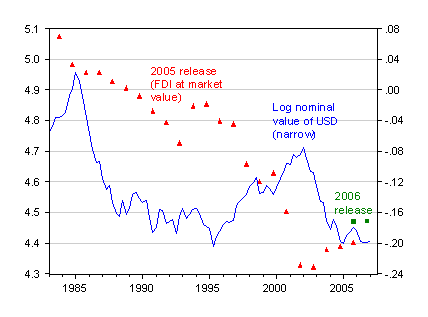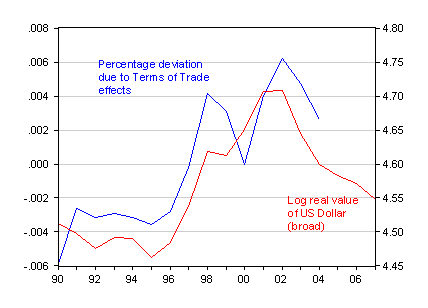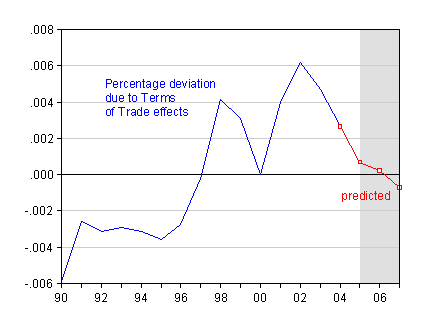Well, maybe not anymore. And perhaps not even before.
The quote is from an article on how the weak dollar is raising the costs of traveling to Europe, as the USD/EUR rate flirts with 1.40. The longer quote, from yesterday’s NYT article entitled “As Dollar Crumples, Tourists Overseas Reel”
, is:
Among some, there is even a sense that turnabout is fair play. Linda Miller, a frequent visitor to Europe from Honolulu, was browsing the other day in the gift shop at the National Gallery of Ireland in Dublin.
Recalling how she and her husband, Stephen, an eye surgeon, had lived large on earlier trips to Europe, Ms. Miller said, “We have always thought that America got away with something.”
While this phenomenon is well known to recent travelers to Europe, it bears repeating, especially as many observers are wont to take the stabilization in the US net international investment position to GDP ratio as unabashed good news.

Figure 1: Ratio of net international investment position divided by nominal end-year GDP, excluding derivatives, and valuing FDI at market value. Source: Author’s calculations based on BEA 2006 IIP release, and NIPA release of June 28, 2007.
The increase in the number of bundles of real U.S. goods and services required to get a single bundle of euro area goods and services highlights the fact that the dollar depreciation over the past five years — which has upwardly revalued U.S. owned assets abroad — also implies a reduction in the terms of trade.
The impact of this relative price effect on GDP is accounted for in the terms-of-trade adjusted GDP series. The Penn World Tables reports this real GDP (in PPP terms) adjusted for terms-of-trade effects, as well as the more conventional GDP adjusted into PPP terms. The (log) ratio of the latter by the former, and the real value of the US dollar (as measured in broad terms by the Fed) are plotted in Figure 2. The stronger the dollar, the larger the terms-of-trade adjusted GDP relative to GDP.

Figure 2: Log ratio of terms-of-trade adjusted GDP to unadjusted GDP (in International dollars, Laspeyres index) and log real value of US dollar against broad basket of curencies. 2007 value of dollar based on first six months. Source: Author’s calculations based on Penn World Tables series RGDPTT and RGDPL, and Federal Reserve Board.
The relationship is pretty strong over the past 15 years; in the earlier period it is less pronounced — but that is to be expected. The terms-of-trade effect is larger the greater (in absolute value) the trade balance to GDP ratio. Regressing the log ratio on the log real value of the dollar leads to the following results:
ratio = -0.18 + 0.04 r
Adj.R2 = 0.79; SER = 0.0017
Where r is the real value of the US dollar. Note that the coefficient on r is statistically significant.
Using this equation to fit the ratio leads to the following figure.

Figure 3: Actual log ratio of terms-of-trade adjusted GDP to unadjusted GDP (in International dollars, Laspeyres index) predicted values. Gray shading denotes forecast period. Source: Author’s calculations based on Penn World Tables series RGDPTT and RGDPL, and Federal Reserve Board.
In other words, from 1998 (in the wake of the East Asian crisis) up until 2002 (with a year’s exception), the US benefitted from the strong dollar; since then, the depreciating dollar has lead to an erosion of this effect. As of the first half of 2007, the effect is such that the terms-of-trade adjusted GDP is less than the unadjusted GDP. The 0.007 percentage point shift implies a relative loss of about $81 billion (in 2000$). That effect will continue to increase as long as the dollar continues to decline.
(See Truman (2005) [pdf] for a different estimate of terms of trade loss — roughly $300 billion for a 30% nominal depreciation.)
Technorati Tags: net international investment position,
terms of trade,
trade balance.
I can see how this would impact something such as Delta’s costs if they decide to go with a big Airbus order, but does a “weak” dollar harm the economy as a whole very much if at all?
Allen: It isn’t that a weak dollar “harms” the economy. Exchange rate movements are part of the adjustment process. However, some people latch onto the stabilization of the NIIP/GDP ratio to argue that large deficits are costless. My point is that the stabilization in NIIP/GDP that has occurred has been partly accomplished with dollar depreciation that entails erosion of purchasing power in real terms.
Personally, I really don’t see the point of spending hard earned money on ungrateful Europeans. There are plenty of fine places to travel to in the US and East Asia. The same logic applies to almost every other commodity.
If I understand this correctly, it implies that when we buy goods and services outside the US (especially Europe) we are paying “too much” because of USD devaluation. Is that correct?
The other side though is that our goods and services should be cheaper to them …so this should increase US exports. And it seems like this should increase GDP…
Is it that it doesn’t count toward GDP because foreigners are spending their USDs on T-Bills, property and hedge funds??
Well, this was what I found interesting in the same NYT article:
It is also reflected in the tourism statistics in France, Germany, Spain and other countries, which show that the number of Americans visiting Europe has increased this year, even as the value of the dollar has eroded.
Menzie wrote:
My point is that the stabilization in NIIP/GDP that has occurred has been partly accomplished with dollar depreciation that entails erosion of purchasing power in real terms.
Menzie,
A great point!
NoFate,
You are correct in your statements but realize that when depreciation of the currency increases prices on imports and decreases prices on exports the consumers in the domestic country actually pay the price.
Consider the US as an example. The depreciation of the dollar actually steals purchasing power, wealth, away from the holders of dollars. Who holds a majority of dollars? The American people.
So where does that wealth go? It is incorporated into the lower prices of exports to foreign countries. Essentially this means that the foreign country is receiving a subsidy from the American people. The Japanese people have been subsidizing the rest of the world for decades. Now this has given the Japanese market share but it came at a cost of the Japanese standard of living.
When the government debases the currency to increase exports it is actually stealing from the people to distribute to exporters and by extension foreign countries. It should be clear that debasing the currency actually reduces growth in the exporting country while subsidizing growth in the importing country.
DickF wrote:
“When the government debases the currency to increase exports it is actually stealing from the people to distribute to exporters and by extension foreign countries.”
True.
But you forget our innovative American approach to this– debase the currency and the industrial base at the same time. Are there any long-term examples of how this has worked out in the past. Personally, I doubt there are any that involve a reserve currency.
But you forget our innovative American approach to this– debase the currency and the industrial base at the same time.
I think the UK pioneered this some time ago, in the end it hasn’t worked out too badly, but of course the UK is much smaller.
George wrote:
“I think the UK pioneered this some time ago, in the end it hasn’t worked out too badly, but of course the UK is much smaller.”
Good point.
However, if I recall correctly (no guarantees), the UK was running a trade surplus while declining as an empire. I’ve no doubt their industrial base was shrinking, but at a slower rate that allowed them to transition to their current status. I would feel more comfortable if we were only debasing the currency to strengthen the industrial base.
debasing the currency actually reduces growth in the exporting country while subsidizing growth in the importing country
May be in nominal terms, but not in physical production. China is an example, its currency is very cheap and it is growing very fast. It is possible that the 40% devaluation of the US dollar against the Euro may not be enough, it has to devaluate also against the Chinese yuan.